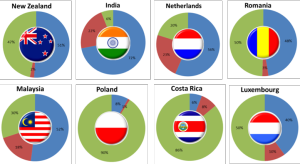Email marketers have spent years building best-practice expertise to deliver the most effective email campaigns possible. However the age old challenge of not being able to reach subscribers’ inboxes continues to be a problem for marketers worldwide.
In 2013, 100.5 billion business emails were sent and received every day. The sheer volume of email traffic and the growing sophistication of spam tactics have contributed to the issue marketers now face to stay at the top of consumers’ inboxes.
We have already seen the impact of spam emails on high profile brands such as Apple and Dropbox, as well as authentic looking emails pandering to the concerns of the public off the back of topical news stories, in order to build trust and falsely obtain users personal credentials. Mailbox providers are therefore constantly redefining their filters to help prevent these kinds of messages getting through which in turn, forces legitimate email senders to become equally as sophisticated to improve their own inbox placement.
Recent research conducted by Return Path (Inbox Placement Report 2014) of more than 492 million commercial email messages sent across North and South America, Europe and Asia Pacific regions, shows that one in six commercial messages do not reach the subscriber’s inbox. This is consistent with last year’s findings, which indicates that while marketers have a basic understanding of how to keep out of the junk folder, there is still more to learn on further maximising inbox placement.
According to the results, 11 percent of commercial messages simply go missing while six percent are marked as spam. This presents a significant problem for marketers who value and rely on the long-term customer relationship that email marketing can build. If messages go missing completely, businesses risk losing customers; failing to reach the inbox simply means failing to reach the customer. The financial impact here is great, for example, if 50 percent of messages are unsuccessfully delivered, that equates to 50 percent of the email marketing campaign budget being lost as well.
Return Path has discovered that being ranked as a ‘good sender’ by ISPs is no longer enough to guarantee inbox placement. We have seen that most countries across the globe are struggling to achieve at least 90 percent inbox placement rates, including developed markets such as the UK and US.

Our research shows that Eastern European countries particularly struggle with messages going missing. Senders in Romania and Luxembourg are seeing 50 percent of their emails failing to reach the inbox, while in Poland this figure reaches a staggering 90 percent. This means that a significant portion of their audience doesn’t receive any intended commercial email. Email messages that go missing are harder to identify and diagnose, however, the first step in being able to correct the problem and boost inbox performance is knowing where the problem lies.
Inbox Placement Rates – Country Breakdown
Surprisingly, these European countries fared better than the likes of the US when it comes to messages landing incorrectly landing in the spam folder; however the Netherlands still saw 23 percent of legitimate marketing emails being marked as spam. Subscribers rarely engage with these messages in the junk folder therefore contribute as little to marketing ROI as missing emails do.
This trend is not restricted to these European regions. New Zealand also struggled throughout 2013. Almost half of the messages monitored by Return Path disappeared altogether. Similarly Brazil lost nearly one-third of commercial messages sent. But most notably, Costa Rica has found it the most difficult to keep up with the industry’s change of pace and the developments made by mailbox providers, and has one of the lowest inbox placement rates globally at just six percent.
Email marketing continues to develop, and good email marketers have the right knowledge in place to adapt to these industry changes. Defining, measuring and managing inbox placement will only become even more important and will continue to change as consumer’s email experiences change.
Defining
As more mailbox providers go down the compartmentalised route, something which we have already seen from Gmail, messages being marked as in or out of the inbox becomes more complicated. For example, messages that go directly to Gmail’s ‘Promotions’ tab qualify as placed mail, the same as those delivered to the ‘Primary’ tab.
Measuring
One dimensional views of inbox placement are also inaccurate in today’s industry. Larger mailbox providers are now placing greater emphasis on consumers’ engagement with email as a contributing factor to inbox placement. A message may reach the primary inbox of a subscriber but this doesn’t give any indication of whether they have opened it and engaged with it.
Rethinking management tactics
Gone are the days where following a single set of best practice guidelines was an effective way to ensure successful inbox placement across a multitude of mailboxes. Email marketing programmes should be tailored for different mailbox providers as well as subscribers, taking into account levels of activity and behaviours. Having the correct knowledge in place to tailor these email programmes will ensure marketers are reaching their full potential.
The interplay between inbox placement and engagement, reputation, and marketing tactics is critical to maximising email ROI. If only 60 percent of emails are reaching the inbox then that leaves scope to improve and better the success of the email programme by 40 percent – this presents companies with a key lever to drive stronger marketing performance. By understanding the challenge of inbox placement and how mailbox providers are protecting users from unwanted emails, marketers can begin to improve their placement rates and maintain that important line of communication with their customers.







